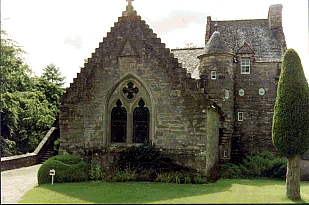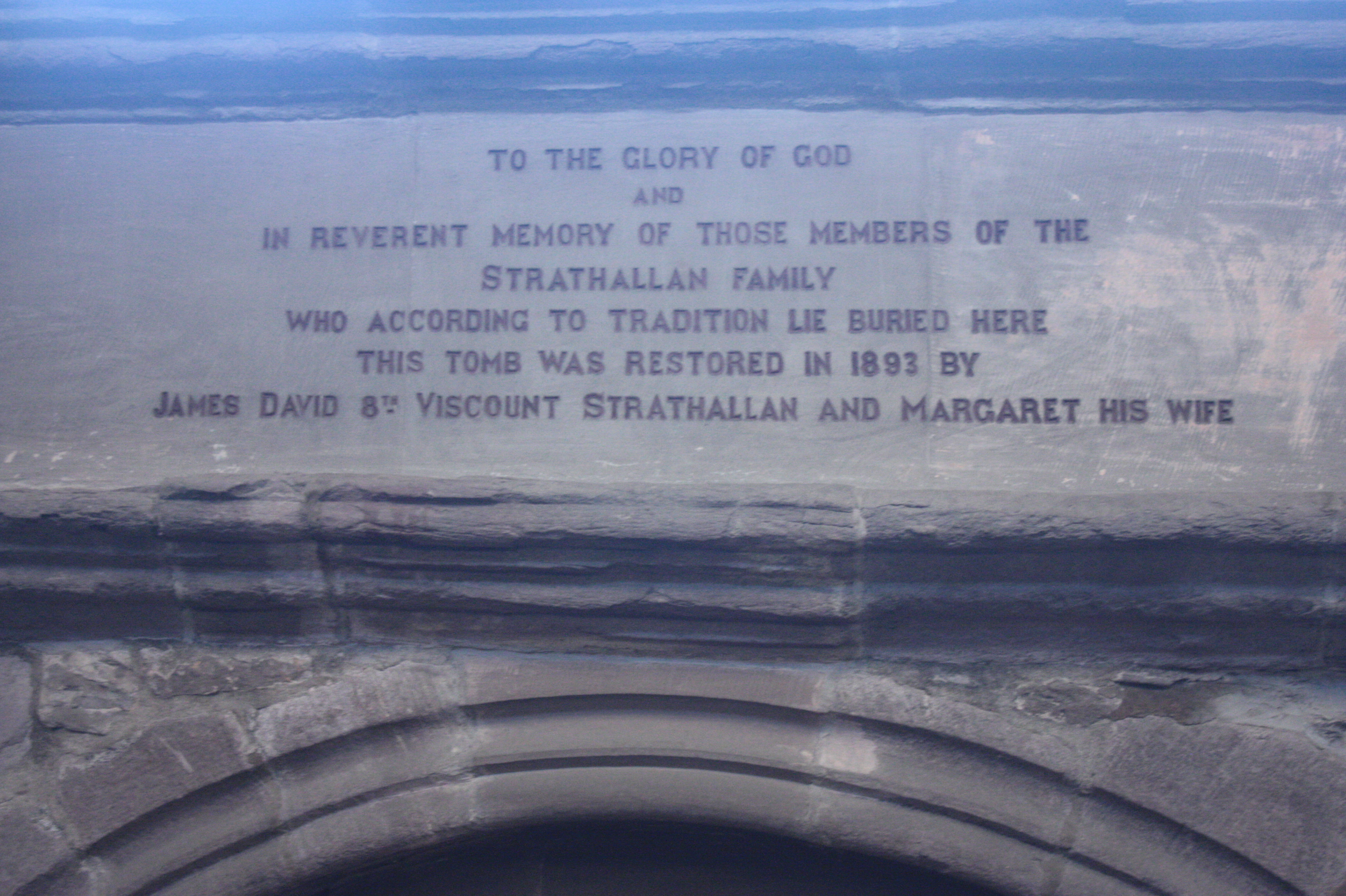|
Kinbuck
Kinbuck is a hamlet in Stirlingshire, Scotland. It lies by the Allan Water and the Stirling-Perth Railway line. It is four miles north of Dunblane. Facilities Despite a campaign to save it, Kinbuck Primary School was controversially closed in 1998. At the time its closure was announced the school had just 24 pupils and the action saved the local authority over £30000 annually. Students from the village were then sent to nearby Newton Primary School. The Victorian building remains standing and is now used as the village's community centre, where several events are held annually for all to attend. History Kinbuck was the location of the retreat of the Jacobite troops under the Earl of Mar following the Battle of Sheriffmuir on 13 November 1715. Nearby is the B listed Kinbuck Bridge as well as the A listed Cromlix House, former seat of Viscount Strathallan and the Clan Drummond Clan Drummond is a Highland Scottish clan.Way, George and Squire, Romily. (1994). ''Collins Sc ... [...More Info...] [...Related Items...] OR: [Wikipedia] [Google] [Baidu] |
Kinbuck Bridge
Kinbuck Bridge or Bridge of Kinbuck is a category B listed structure in the hamlet of Kinbuck in Stirling. History The present structure is dated 1752. In 1715, after resting for the night in Kinbuck, 6,000 Jacobite troops crossed Kinbuck bridge over the River Allan on their way to fight the Hanoverians at the Battle of Sherrifmuir. Design It has two spans, and the central cutwater In architecture, a starling (or sterling) is a defensive bulwark, usually built with pilings or bricks, surrounding the supports (or piers) of a bridge or similar construction. Starlings may be shaped to ease the flow of the water around the bri ... is protected by a concrete island. The weight limit on the bridge is . References External links {{coord, 56.2256, -3.9512, type:landmark_region:GB, display=title Category B listed buildings in Stirling (council area) Listed bridges in Scotland Bridges completed in 1752 ... [...More Info...] [...Related Items...] OR: [Wikipedia] [Google] [Baidu] |
Allan Water
The Allan Water ( gd, Uisge Alain) is a river in central Scotland. Rising in the Ochil Hills, it runs through Strathallan to Dunblane and Bridge of Allan before joining the River Forth. It is liable to cause floods in lower Bridge of Allan. It shares its name with a tributary of the River Teviot. The name is similar to the Ale Water in Berwickshire, the River Alness in Ross-shire, the Allander Water in Stirlingshire, the River Alne and the Ayle Burn in Northumberland, the River Ellen in Cumbria, and several names in the south of England, Wales and Cornwall. Ptolemy, who wrote his Geography about 150 AD, gave the names of some of these rivers as Alauna or Alaunos. Ekwall says that Alauna or Alaunos are British .e. Brythonic or P-Celticriver names. Nicolaisen says that the name Allan is of Pre-Celtic Indo-European origin. Its original form was Alauna, from the Indo-European root *el-/ol-, meaning "to flow, to stream". Several European rivers and settlements have names that may ... [...More Info...] [...Related Items...] OR: [Wikipedia] [Google] [Baidu] |
Stirling (council Area)
The Stirling council area ( sco, Stirlin; gd, Sruighlea) is one of the 32 council areas of Scotland, and has a population of about ( estimate). It was created under the Local Government etc (Scotland) Act 1994 with the boundaries of the Stirling district of the former Central local government region, and it covers most of Stirlingshire (except Falkirk) and the south-western portion of Perthshire. Both counties were abolished for local government purposes under the Local Government (Scotland) Act 1973. The administrative centre of the area is the city of Stirling, with the headquarters at Old Viewforth. The area borders the council areas of Clackmannanshire (to the east), North Lanarkshire (to the south), Falkirk (to the south east), Perth and Kinross (to the north and north east), Argyll and Bute (to the north and north west), and both East and West Dunbartonshire to Stirling's southwest. The majority of the population of the area is located in its southeast corne ... [...More Info...] [...Related Items...] OR: [Wikipedia] [Google] [Baidu] |
Cromlix House
Cromlix House is a Victorian mansion near Kinbuck, Perthshire. A house was built on the site in 1874 as a family residence in the time of Captain Arthur Drummond Hay, but was destroyed by fire in 1878. It was replaced in 1880 by the house which forms the nucleus of the present building, and was subsequently operated as a hotel. The hotel closed in 2011 and in early 2013 it was bought by tennis player Andy Murray. The hotel re-opened in April 2014 under the name Cromlix, managed by Inverlochy Castle Management International (ICMI). History There are records of Cromlix from the 1500s when the Bishop of Dunblane sold the lands of Cromlix to his brother, Robert Chisholm. The present house was built for Arthur Hay-Drummond, son of the Earl of Kinnoul. King Edward VII visited in September 1908. The house remained a family home for the Hay-Drummonds until the death of Evelyn Hay-Drummond in 1971, who had married Terence Eden (8th Lord Auckland). Cromlix House was converted in May 1981 ... [...More Info...] [...Related Items...] OR: [Wikipedia] [Google] [Baidu] |
Clan Drummond
Clan Drummond is a Highland Scottish clan.Way, George and Squire, Romily. (1994). ''Collins Scottish Clan & Family Encyclopedia''. (Foreword by The Rt Hon. The Earl of Elgin KT, Convenor, The Standing Council of Scottish Chiefs). pp. 120 - 121. The surname is rendered "Druimeanach" in modern Scottish Gaelic.Urquhart, Libby. (1997). ''The Drummonds''. Published by Lang Syne Publishers Ltd. . History Origins of the clan Traditional origins West of Stirling is the parish of Drymen and its name appears to have been derived from the Scottish Gaelic, ''dromainn'' which means a ''ridge'' or ''high ground''. There is a traditional legend that states that the first nobleman to settle in Drymen was a Hungarian prince called George who accompanied Edgar Ætheling, an Anglo-Saxon prince, on his escape from William the Conqueror and the Norman conquest of England. These royal fugitives were warmly welcomed by Malcolm III of Scotland, who married one of the royal sisters, Margaret, later ... [...More Info...] [...Related Items...] OR: [Wikipedia] [Google] [Baidu] |
Viscount Strathallan
{{Use dmy dates, date=November 2019 The title of Lord Maderty was created in 1609 for James Drummond, a younger son of the 2nd Lord Drummond of Cargill. The titles of Viscount Strathallan and Lord Drummond of Cromlix were created in 1686 for William Drummond, a younger son of the 2nd Lord Madderty. Both creations were in the Peerage of Scotland, and are now held by the Earl of Perth. Lords Maderty (1609) * James Drummond, 1st Lord Maderty (d. July 1623) *John Drummond, 2nd Lord Maderty (d. 1647) *David Drummond, 3rd Lord Maderty (d. 20 January 1692) ''title passes to a descendant of the 1st Viscount Strathallan, who becomes 4th Lord Maderty (below)'' Viscounts Strathallan (1686) *William Drummond, 1st Viscount Strathallan (1617 – 23 March 1688) *William Drummond, 2nd Viscount Strathallan (8 August 1670 – 7 July 1702) *William Drummond, 3rd Viscount Strathallan (1694 – 26 May 1711) *William Drummond, 4th Viscount Strathallan (d. Culloden 16 April 1746) * James Drummond, '' ... [...More Info...] [...Related Items...] OR: [Wikipedia] [Google] [Baidu] |
A Listed
This is a list of Category A listed buildings in Scotland, which are among the listed buildings of the United Kingdom. For a fuller list, see the pages linked on List of listed buildings in Scotland. Key The organization of the lists in this series is on the same basis as the statutory register. County names are those used in the register, and in the case of Scotland they parallel the current administrative areas. Category A listed buildings in Scotland See also *List of castles in Scotland *List of country houses in the United Kingdom *List of hillforts in Scotland *List of historic sites in Scotland *List of monastic houses in Scotland *List of National Trust for Scotland properties * List of post-war Category A listed buildings in Scotland * Listed buildings in England * Listed buildings in Northern Ireland *Listed buildings in Wales *Lists of listed buildings in Scotland *Signal boxes that are listed buildings in Scotland __NOTOC__ A number of signal boxes in Sc ... [...More Info...] [...Related Items...] OR: [Wikipedia] [Google] [Baidu] |
B Roads In Zone 8 Of The Great Britain Numbering Scheme
B roads are numbered routes in Great Britain of lesser importance than A roads. See the article Great Britain road numbering scheme for the rationale behind the numbers allocated. Zone 8 (3 digits) Zone 8 (4 digits) See also * A roads in Zone 8 of the Great Britain numbering scheme * List of motorways in the United Kingdom This list of motorways in the United Kingdom is a complete list of motorways in the United Kingdom. Note that the numbering scheme used for Great Britain does not include roads in Northern Ireland, which are allocated numbers on an ad hoc basis ... * Transport in Glasgow#Other Roads * Transport in Scotland#Road References {{DEFAULTSORT:B Roads In Zone 8 Of The Great Britain Numbering Scheme 8 ... [...More Info...] [...Related Items...] OR: [Wikipedia] [Google] [Baidu] |
The Herald (Glasgow)
''The Herald'' is a Scottish broadsheet newspaper founded in 1783. ''The Herald'' is the longest running national newspaper in the world and is the eighth oldest daily paper in the world. The title was simplified from ''The Glasgow Herald'' in 1992. Following the closure of the '' Sunday Herald'', the ''Herald on Sunday'' was launched as a Sunday edition on 9 September 2018. History Founding The newspaper was founded by an Edinburgh-born printer called John Mennons in January 1783 as a weekly publication called the ''Glasgow Advertiser''. Mennons' first edition had a global scoop: news of the treaties of Versailles reached Mennons via the Lord Provost of Glasgow just as he was putting the paper together. War had ended with the American colonies, he revealed. ''The Herald'', therefore, is as old as the United States of America, give or take an hour or two. The story was, however, only carried on the back page. Mennons, using the larger of two fonts available to him, put it i ... [...More Info...] [...Related Items...] OR: [Wikipedia] [Google] [Baidu] |
Dunblane
Dunblane (, gd, Dùn Bhlàthain) is a small town in the council area of Stirling in central Scotland, and inside the historic boundaries of the county of Perthshire. It is a commuter town, with many residents making use of good transport links to much of the Central Belt, including Glasgow and Edinburgh. Dunblane is built on the banks of the Allan Water (or River Allan), a tributary of the River Forth. Dunblane Cathedral is its most prominent landmark. Dunblane had a population of 8,114 at the 2001 census, which grew to 8,811 at the 2011 census; both of these figures were computed according to the 2010 definition of the locality. In mid-2016 it was estimated that the population had grown to 9,410. Origin of name The most popular theory for the derivation of the name "Dunblane" is that it means "fort of Blane", commemorating Saint Blane (or Blán in Old Irish), an early Christian saint who lived probably in the late 6th century. His main seat was originally Kingarth on the ... [...More Info...] [...Related Items...] OR: [Wikipedia] [Google] [Baidu] |




